Related Research Articles

Ceiba is a genus of trees in the family Malvaceae, native to tropical and subtropical areas of the Americas and tropical West Africa. Some species can grow to 70 m (230 ft) tall or more, with a straight, largely branchless trunk that culminates in a huge, spreading canopy, and buttress roots that can be taller than a grown person. The best-known, and most widely cultivated, species is Kapok, Ceiba pentandra, one of several trees called kapok.
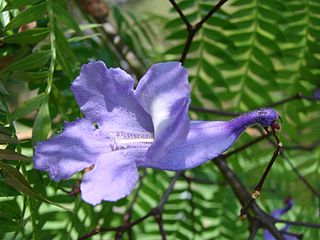
Jacaranda is a genus of 49 species of flowering plants in the family Bignoniaceae, native to tropical and subtropical regions of Latin America and the Caribbean.

Cleistocactus is a genus of flowering plants in the cactus family Cactaceae, native to mountainous areas - to 3,000 m (9,843 ft) - of South America. The name comes from the Greek kleistos meaning closed because the flowers hardly open.

Rauvolfia is a genus of evergreen trees and shrubs, commonly known as devil peppers, in the family Apocynaceae. The genus is named to honor Leonhard Rauwolf. The genus can mainly be found in tropical regions of Africa, Asia, Latin America, and various oceanic islands.
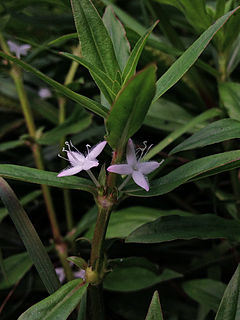
Diodia is a genus of flowering plants in the family Rubiaceae. It was described by Carl Linnaeus in 1753. The genus is found from southern and eastern United States, South America, Central America, Mexico, the West Indies and tropical Africa.

Sterculia is a genus of flowering plants in the mallow family, Malvaceae: subfamily Sterculioideae. Members of the genus are colloquially known as tropical chestnuts. The scientific name is taken from Sterculius of Roman mythology, who was the god of manure; this is in reference to the unpleasant aroma of the flowers of this genus. Sterculia may be monoecious or dioecious, and flowers unisexual or bisexual.

Calathea is a genus of plants belonging to the family Marantaceae. There are several dozen species in this genus. Native to the tropical Americas, many of the species are popular as pot plants due to their decorative leaves and, in some species, colorful inflorescences. They are commonly called calatheas or prayer plants.
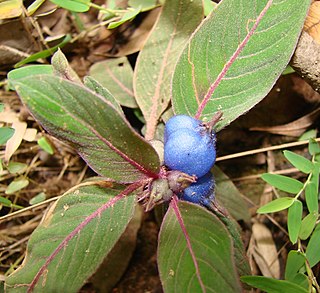
Coccocypselum is a genus of flowering plants in the family Rubiaceae. It is native to Mexico, Central America, the West Indies and South America. All species of the genus Coccocypselum are herbaceous with fleshy, blue or purple fruits, and 4-petaled flowers.
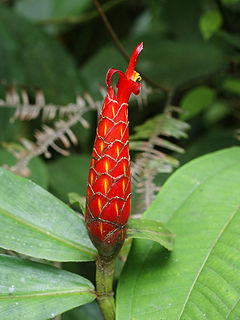
Costus is a group of perennial herbaceous plants in the family (Costaceae) described by Linnaeus as a genus in 1753. It was formerly known as Hellenia after the Finnish botanist Carl Niclas von Hellens. It is widespread through tropical and subtropical regions of Asia, Africa, and the Americas.
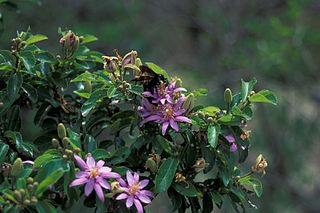
The large flowering plant genus Grewia is today placed by most authors in the mallow family Malvaceae, in the expanded sense as proposed by the Angiosperm Phylogeny Group. Formerly, Grewia was placed in either the family Tiliaceae or the Sparrmanniaceae. However, these were both not monophyletic with respect to other Malvales - as already indicated by the uncertainties surrounding placement of Grewia and similar genera - and have thus been merged into the Malvaceae. Together with the bulk of the former Sparrmanniaceae, Grewia is in the subfamily Grewioideae and therein the tribe Grewieae, of which it is the type genus.
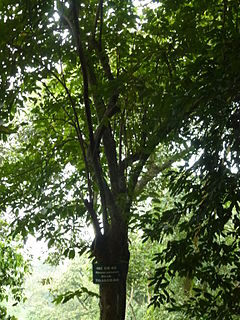
Microcos is a genus of flowering plants in the family Malvaceae sensu lato or Tiliaceae or Sparrmanniaceae.
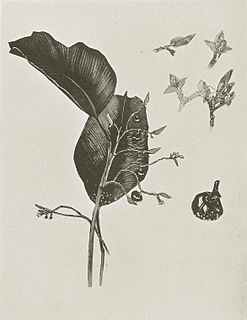
Sarcophrynium is a genus of plant in family Marantaceae indigenous to tropical Africa. It was described as a genus in 1902.
Limenavis is a prehistoric bird genus from the Late Cretaceous. It lived about 70 million years ago, around the Campanian-Maastrichtian boundary. Known from several broken bones, the remains of the only known species Limenavis patagonica were found in rocks of the "lower member" of the Allen Formation at Salitral Moreno, 20 km south of General Roca, Río Negro (Argentina).

Maranta is a genus of flowering plants in the family Marantaceae, native to tropical Central and South America and the West Indies. Maranta was named for Bartolomeo Maranta, an Italian physician and botanist of the sixteenth century.
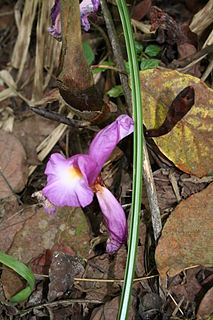
Aframomum is a genus in the ginger family, Zingiberaceae. It is widespread across tropical Africa as well as on some islands of the Indian Ocean. It is represented by approximately 50 species. It is larger than other genera in its family. Its species are perennials and produce colorful flowers.
Baissea is a genus of plant in the family Apocynaceae found in tropical Africa. As of August 2013 the World Checklist of Selected Plant Families recognises 18 species:

Chassalia is a genus of flowering plants in the family Rubiaceae. The genus is found from tropical Africa to (sub)tropical Asia.
Maevia Noemí Correa (1914-2005) was an Argentine botanist, researcher, botanical curator, and professor. She studied at the Faculty of Natural Sciences and Museum Studies at the National University of La Plata, and in 1953 completed a doctorate in natural sciences at the same university, with a dissertation titled, "Las Orquídeas Argentinas de la Tribu Polychondreae Schltr., subtribu Spiranthinae Pfitzer", under the direction of Dr. Ángel Lulio Cabrera. Between 1956 and 1957, the American Association of University Women sponsored her study at the University of California, Berkeley. From 1956 to 1958, she served as technical researcher at the Ministerio de Agricultura y Ganadería, and the Botany Institute in Argentina. She is associated with the National Agricultural Technology Institute (NITA) and served there between 1958 and 1983 as a technical researcher. She worked on several projects during her career including "Estudio y relevamiento de la Flora Patagónica", and "Estudio taxonómico de la Flora Patagónica". She served as herbarium curator, and as the Argentine National Coordinator of the Regional Flora Plan (1981-1990).

Allenrolfea is a genus of shrubs in the family Amaranthaceae. The genus was named for the English botanist Robert Allen Rolfe. There are three species, ranging from North America to South America.
References
- ↑ The Plant List, Duseniella patagonica (O.Hoffm.) K.Schum.
- ↑ Schumann, Karl Moritz. 1902. Just's botanischer Jahresbericht. Systematisch geordnetes Repertorium der botanischen Literatur aller Lander 28(1): 475
- ↑ Tropicos, Duseniella K. Schum.
- ↑ Flann, C (ed) 2009+ Global Compositae Checklist [ permanent dead link ]
- ↑ Zuloaga, F. O., O. Morrone, M. J. Belgrano, C. Marticorena & E. Marchesi. (eds.) 2008. Catálogo de las plantas vasculares del Cono Sur. Monographs in systematic botany from the Missouri Botanical Garden 107(1–3): i–xcvi, 1–3348.